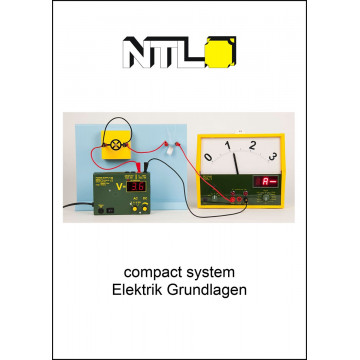


Manual and worksheets for Electrics and Electromagnetism of the magnetic block system "compact" (MBC), comprising the following topics: Basic circuits, conductors & non-conductorsELC 01.01 The electrical circuitELC 01.02 * Double-throw switchELC 01.03 * Two-way switchELC 01.04 VoltageELC 01.05 Serial connection of voltage sourcesELC 01.06 Parallel connection of voltage sourcesELC 01.07 Terminal voltage – Idle voltageELC 01.11 AmperageELC 01.12 Conductors and non-conductors - solidsELC 01.13 Conductors and non-conductors - liquidsELC 01.14 Is the human body an electrical conductor?ELC 01.15 Is the human body an electrical conductor in contact with water?ELC 01.16 Closing a circuit by grounding Electrical ResistanceELC 02.01 Ohm’s law ELC 02.02 Application of Ohm’s lawELC 02.03 * Measuring resistance with an OhmmeterELC 02.04 Is the resistance of a wire depending on its length and its diameter?ELC 02.05 * Is the resistance of a wire depending on its material and temperature?ELC 02.06 Is an incandescent lamp an ohmic resistor?ELC 02.07 Serial connection of incandescent lampsELC 02.08 Serial connection of ohmic resistorsELC 02.09 Parallel connection of incandescent lampsELC 02.10 Parallel connection of ohmic resistorsELC 02.11 * Ohmic resistors in parallel and series circuitsELC 02.12 Voltage divisionELC 02.13 Model of potentiometerELC 02.14 * Dimming by means of a potentiometer Thermal energy derived from electrical energyELC 03.01 Electrical energy is converted into thermal energyELC 03.02 The incandescent effect of a filamentELC 03.03 Conducting wires and resistance wiresELC 03.04 Safety fuse Work and powerELC 04.01 Work and power of electrical currentELC 04.02 * Work and power of an electric motor Electromagnetic InductionELC 05.01 Induction voltages in conductor loopsELC 05.02 Creation of induced voltage in a coilELC 05.03 Dependence of induced voltage on the number of turns of a coilELC 05.04 Dependence of induced voltage on the speed of movement ElectromagnetismELC 06.01 * A current-carrying conductor creates a magnetic fieldELC 06.02 Magnetic field lines around a current-carrying conductorELC 06.03 Magnetic field lines around a current-carrying conductor loopELC 06.04 Magnetic field lines around a coilELC 07.01 A current-carrying coil creates a magnetic fieldELC 07.02 The magnetic field of a current-carrying coilELC 07.03 Magnetic force of a current-carrying coilELC 07.04 Dependence of the magnetic force on the number of turns from a current-carrying coilELC 07.05 The principle of the electromagnetELC 07.06 Opening and closing a circuit with the aid of a magnetELC 07.07 Model of a relay with make contact ELC 07.08 Model of a relay with make and break contactELC 07.09 A self-interrupting circuit ELC 07.10 The electric bellELC 07.11 Effect of force on a current-carrying conductor in a magnetic field - conductor swing TransformatorELC 08.01 Voltage transmission on a non-loaded transformerELC 08.02 Current is also transformedELC 08.03 Model of an induction melting furnace ELC 08.04 Thomson cannonThe experiments marked with * require additional material outside from the MBC Electricity set and the MBC Electromagnetism set.